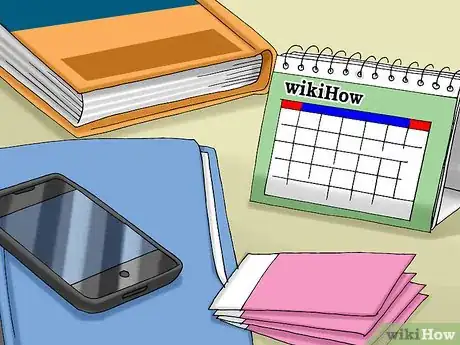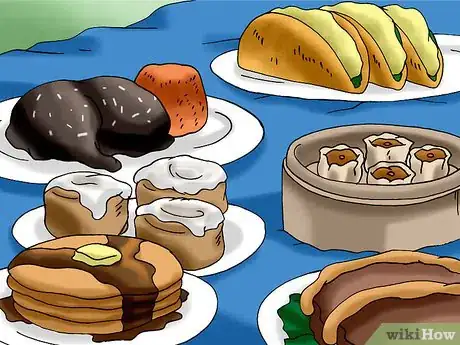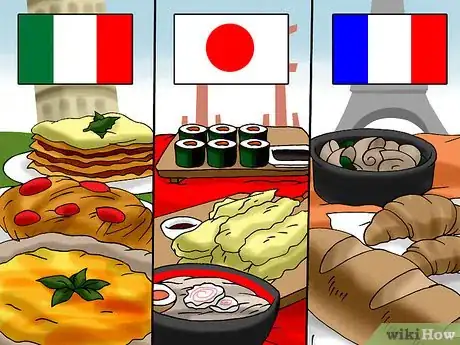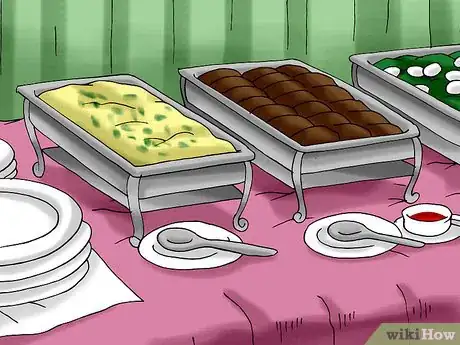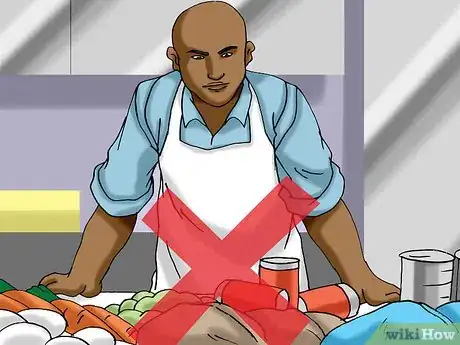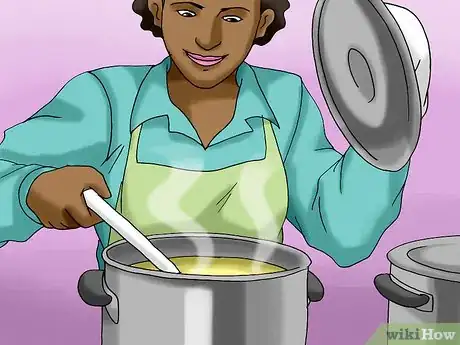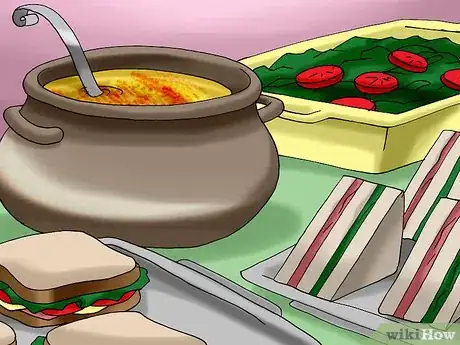This article was co-authored by Karen Brown. Karen Brown is the Founder and Creative Director of Karen Brown New York, a full service event planning company. Karen has planned hundreds of successful weddings, corporate parties, award ceremonies, product launches, galas, and fundraisers over the past decade throughout the United States, Mexico, and Canada.
There are 11 references cited in this article, which can be found at the bottom of the page.
This article has been viewed 125,823 times.
Weddings can be quite expensive in general, with roughly half of those costs going to the reception and catering alone. Doing the catering yourself can help reduce those costs. However, it’s still easy to go over-budget without careful planning, so an organized approach is needed to ensure success. From there, deciding on a menu is a matter of being flexible and open-minded with an eye toward simplicity. Finally, enlisting help and delegating tasks will help you put your plan into action with minimal headaches.
Steps
Setting Yourself Up for Success
-
1Start planning ASAP. There's no such thing as too early, so begin researching and planning your menu right away (ideally no later than when you settle on a date). Whichever direction you decide to go, expect the unexpected. Give yourself plenty of time to address any unforeseen problems or overlooked details that might pop up along the way. Remember that, in addition to cooking up some food for everyone, you will also have to deal with issues like:[1]
- Supplies
- Servers
- Storage
- Transportation
- Kitchen space and equipment
-
2Be organized from the get-go. Remember that catering is just one facet of your wedding, which means plenty of other details will demand your attention between now and then. Don’t trust things to memory. Make organization a priority. As you start your research and planning, keep records for easy reference later on. Create separate binders, computer files, and/or journals for things like:[2]
- Recipes
- Contacts
- Calendars
- Contracts
- Coupons
Advertisement -
3Seek out advice from people with experience. Talk to any friends, family, or other associates who have experience catering large events on their own. Whether it was for a wedding or some other large gathering, ask for their advice on what worked and what they learned from any mistakes. If possible, specifically seek out those whose wedding (or other gathering) mirrors your own plans for your reception, since their advice may apply more directly.[3]
- For instance, an outdoor reception may face unique issues that do not occur with indoor receptions, and vice versa.
-
4Evaluate your reception site. If you’ve already booked a space to hold your reception, take a look at the kitchen and serving facilities. Determine what resources are available. Plan your menu around what can be done in that space, rather than try something too ambitious that the space isn’t equipped for. If you haven’t decided on a space, use the same considerations as a deciding factor. Pay attention to things like:[4]
- The number and size of ovens, freezers, and refrigerators.
- Which cookware is provided and which you will need to provide yourself.
- The number and location of power sources for electrical equipment.
-
5Determine your budget. Most importantly, decide how much you are willing to spend on your wedding in general. Expect the reception and catering to take up roughly half of this figure. Devote half of your budget to these costs for now.[5]
- Catering the wedding yourself can lower your expenses significantly. However, it’s still better to assume that it will cost just as much as hiring professionals. This way you’re more likely to have money in reserve to cover or lower any unexpected costs.[6]
-
6Include insurance in your catering budget. Keep in mind that you can be held liable for any unforeseen disasters that might occur due to what you serve and how. Don’t expect to be exempt from this just because you aren’t a professional caterer. If you don’t have already have a policy that will cover this event, factor in the cost of a single-event policy that includes:[7]
- Accidents
- Injuries
- Food poisoning
-
7Make your guest list. Find out how many people you plan on serving. However, don’t send out invitations just yet. Keep this list to yourself for now so you can adjust it as needs be without hurting anyone’s feelings. Create categories for people you definitely want to be there and others you would like to have, but who could be scratched to keep your budget in check.[8]
- Aim for a total guest list that’s less than 125 people. Expect preparing and serving food for any more than that to be unfeasible without the use of commercial equipment, storage space, and staff.
Coming Up with Menu Ideas
-
1Cast your net wide. When you first start pondering what to serve, don’t worry about coming up with a master plan right off the bat. Brainstorm as many different options as possible. You may have a pretty firm idea of what you want at first, but you may find that you need to revise or scrap plans entirely as you go along, so have plenty of back-up ideas in reserve. Variables that might affect your final decision include your:[9]
- Budget
- Culinary skills
- Storage space available
- Available cookware and/or kitchen facilities at home
- Reception site’s kitchen facilities.
-
2Take your itinerary into consideration. If the timing of your ceremony and reception is already set in stone, refer to your schedule to decide what sort of menu to plan. If not, plan your wedding day around your food to make things easier on yourself. Expect your guests to expect a full meal if your reception occurs during meal times. Otherwise, simply prepare the appropriate food items for the service specified on your invitations, like “Dessert reception to follow.” Traditional hours and popular menu ideas include:[10]
- Breakfast (9 a.m. to 11 a.m): waffles, pancakes, eggs. crepes, cinnamon buns, muffins, danishes.[11]
- Brunch (11 a.m. to 2 p.m): frittatas, grilled vegetables, smoked meats, open-face sandwiches, omelets, French toast.[12]
- Lunch (12 p.m. to 3:30 p.m): salads, frittatas, tacos, focaccia, paella, mole chicken, shredded meat with rice and vegetables.
- Afternoon tea with snacks (2 p.m. to 4 p.m): tea sandwiches, chicken salad, egg salad, scones, meat on toast.
- Dinner or full cocktail buffet (5 p.m. to 8 p.m.): salad, canapes, dumplings, fajitas, antipasti, pasta, salmon, chicken, lamb, steak, turkey.
- Hors d’oeuvres (8 p.m. to ?): toast bar, fish and chips, fruit, oysters, salad, shrimp, kebabs.[13]
- Dessert (9 p.m. to ?): cake, cupcakes, ice cream, macaroons, cookies, pie, brownies.[14]
-
3Go with a theme if you're stuck. Maybe the sheer number of dishes that you could possibly pick from makes you feel too daunted to start choosing. Or, maybe too many ideas are coming too fast. Either way, if you feel overwhelmed, come up with a theme for you menu. Narrow your choices down instantly by scratching off any that don't fit that theme. For instance, you could:[15]
- Highlight the location of your wedding, like having BBQ if it's in Texas or lobster in Maine.
- Streamline by sticking to just one style of cuisine, like French, Italian, or Japanese.
- Celebrate your relationship with meaningful foods, like the first meal you shared together.
-
4Favor dishes with in-season ingredients. As you brainstorm menu items, keep your wedding date in mind. Earmark dishes that feature meats and produce that are in season at that time of year. Impress your guests with freshness. At the same time, make life easier on yourself by going with ingredients that are sure to be readily available.[16]
- To find out which meats and produce are in season during your wedding, search online for charts like this one: http://www.bbcgoodfood.com/seasonal-calendar/all
-
5Take special considerations in mind. Go over your guest list. Identify anyone who may have special dietary needs or concerns. Figure out how many may require an alternative menu to the one you end up serving everyone else. Needs and concerns may include:[17]
- Vegan or vegetarian options
- Lactose intolerance
- Food allergies
- Religious restrictions
Settling on a Final Plan
-
1Decide on a serving style. If you’re catering your own wedding, keep in mind that your attention is going be pretty divided on the big day. Don’t plan on plating each individual guest’s meal yourself. Instead, go with a less labor-intensive method, like:[18]
- Buffet style
- Cafeteria style
- Family style
-
2Favor easy-to-make food. Whether you’re planning snacks for an afternoon tea service or a full meal for dinner, remember that you’re cooking in bulk. Avoid complex recipes. Save your master-chef skills for smaller affairs and focus instead on foods that can be easily made, stored, and served. Scratch off any recipes that require lots of:[19]
- Prep
- Steps
- Cookware
- Constant supervision
-
3Determine the logistics. As you narrow your different ideas down to just a handful, start focusing on the nuts and bolts for each one. Figure out what labor, supplies, and other logistics are required to execute each plan. This includes (but isn’t limited to):[20]
- Cooking supplies, like ingredients, cookware, and at-home kitchen facilities.
- Storage supplies, such as refrigerators, freezers, food containers, and transportation.
- Serving/warming/cooling supplies, like utensils, dishware, sternos, extension cords, ice, and on-site kitchen facilities.
- Manpower needed to cook, set up, serve, and clean up.
-
4Favor cooked dishes that can be made well in advance. Remember: you’re going to have plenty else to do in the days leading immediately up to your wedding. Plan your menu accordingly so you can prepare the bulk of it (if not all of it) well beforehand. As long as you can safely store it in the meantime, go with dishes that you can prepare weeks in advance (like soups, pasta dishes, or casseroles), which help you avoid or resolve such mishaps as:[21]
- Conflicting demands on your time
- Longer-than-expected cooking or prep times
- Running out of supplies
- Ruined batches
-
5Pad your menu out with room-temperature foods. Avoid the temptation to cook everything. Focus your cooking efforts on doing a couple of dishes really well instead of trying to take on too much at once. Balance out your menu (or even load it) with foods that can be served as is, at room temperature, without any real need of a kitchen, like sandwich meats, salads, and cold soups.[22]
- This is an especially good idea if the reception site's kitchen facilities are limited, and/or you have few hands to help you out on the day of.
-
6Reevaluate your choices. Now that you have a firmer grasp on what each of your menu plans will entail, go over them again to decide which is most feasible. Additionally, reconsider any other decisions about other wedding plans that you’re willing to change (like the site of your reception or the time of day) if doing so will make life easier. Always opt for simplicity to help ensure easy execution and fewer headaches down the road. For instance:[23]
- Change the reception from mealtime to another service to accommodate more guests with less food (like canapes or finger sandwiches).
- Narrow your guest list down to a select few if you will be serving full meals (such as meat dishes that definitely need to be cooked).
- Opt for alternative (or even main) items that satisfy multiple needs and concerns (like a meat- and dairy-free pasta entree for vegan, vegetarian, kosher, and lactose intolerant diets.
-
7Compare the cost to your catering budget again. Once you have settled on a master plan, add up all the expenses needed to execute it. Compare this with the budget that you’ve set aside for reception and catering. Decide whether you’re saving enough to warrant moving forward on your own, or if it may be less of a headache to hire a professional company instead.
- Again, self-catering your wedding can help save as much as a quarter of your total wedding budget. However, if you have little to no experience in serving food on this scale, keep in mind that you may have overlooked some expenses. If self-catering is already taking up half of your total budget, it may be advisable to go with a pro.[24]
Putting Your Plan into Action
-
1Assemble a team. Don’t take the “self” in “self-catering” too literally. Ask volunteers to assist in the making, storing, and transporting of your foods, as well as the set-up, serving, and clean-up at the reception itself. Don’t overburden yourself by taking things on singlehandedly. Seek help from:[25]
- Your partner
- Friends
- Family
-
2Have a trial dinner. Arrange a meal with your team. Make your catering plans the agenda to be discussed. At the same time, make this meal sort of a trial run to identify strengths and weaknesses in your team. Assign each person the same sort of tasks that you’re thinking about assigning them for your wedding. This way you can:[26]
- Reassign tasks if someone else turns out to be better suited for particular jobs.
- Seek out new members for your team if it seems like you'll need more (or better) hands on deck.
- Create teams within teams if two or more members work better when paired together.
-
3Create a calendar and jobs list. When you sit down with your team, create a detailed list of what needs to be done. Just as importantly, specify when each task needs to be completed by. Then determine who is responsible for doing it. Make sure everyone is clear on the details, especially if the success of one task depends upon the completion of another. This may require some reorganizing. For instance:[27]
- Let’s say you are the only person with a house and a big kitchen, while everyone on your team lives in apartments with limited kitchen space. Because of this, anyone assigned with actual cooking will use your kitchen while you take care of other things.
- However, as big as your kitchen is, it isn’t a commercial kitchen. So you still need to schedule assignments in an orderly manner. Therefore, food will have to be made according to how long it can be safely stored.
- Now let’s say the food that will last the longest is your Aunt Janine’s amazing pasta dish, which can be frozen. But unfortunately Aunt Janine won’t be available in the time allotted for making it.
- This means you may have to ask her to give the recipe to someone else and take care of another item when she’s finally available later on.
-
4Hire additional help if desired. Don’t feel like self-catering is an all-or-nothing proposition. Depending on your plans and what you can reasonably expect from your team, decide whether you should divvy tasks up between yourselves and outside professional help. For instance, you can still take care of the bulk of tasks while hiring others to do things like:[28]
- Preparing your wedding cake
- Tending bar
- Serving food
- Cleaning up
-
5Secure in-demand necessities immediately. Go over what needs to be bought and/or rented. Determine which items are readily available at all times and which should be acquired immediately. The latter will vary according to your plans, needs, and available resources, but could include things like:[29]
- The reception site
- Rented storage space
- Cooking equipment
- Serving ware and utensils
- Tables, chairs, and linens
-
6Secure the reception site for the day before the wedding, too. Remember: you might be doing the catering yourself, but that doesn’t mean catering is the only thing you’ll be doing on your wedding day. Make sure you have access to your reception site the day before so you can set everything up with minimal fuss. Reduce the amount of work that needs to be done on the big day itself so you’re not overwhelmed.[30]
- If you’ve already booked your reception site and the day before your wedding is no longer available, expand your team so more people are available to help with the set up.
-
7Hunt for savings on readily available items. If your budget is limitless, this might be less of a concern than the peace of mind of having everything you need right from the get-go. If not, though, refer to your plan’s calendar. Identify when you will need to secure the more easy-to-get items for each task. Spend the time in between hunting for deals by:
- Comparing prices between stores.
- Finding items available in bulk for less money.[31]
- Taking advantage of coupons, sales, and discounts.
- Determining whether it will be cheaper to rent or buy equipment.
-
8Make a plan for afterwards, too. Remember: prepping and serving your food are only part of what needs to be done. Keep in mind that there will be plenty of work left to do once the reception ends. Since you yourself may be off and away to your honeymoon by this time, make sure you select trustworthy people to take care of these in your absence. Tasks to be done could include:[32]
- Clean-up and removal of all personal equipment and belongings.
- Disposal, storage, or donation of leftover food.
- Return of all rental equipment.
Expert Q&A
-
QuestionHow can I cater a wedding for cheap?
 Karen BrownKaren Brown is the Founder and Creative Director of Karen Brown New York, a full service event planning company. Karen has planned hundreds of successful weddings, corporate parties, award ceremonies, product launches, galas, and fundraisers over the past decade throughout the United States, Mexico, and Canada.
Karen BrownKaren Brown is the Founder and Creative Director of Karen Brown New York, a full service event planning company. Karen has planned hundreds of successful weddings, corporate parties, award ceremonies, product launches, galas, and fundraisers over the past decade throughout the United States, Mexico, and Canada.
Wedding & Event Planner As you're planning your menu, think about what foods will be in season at the time of your wedding.
As you're planning your menu, think about what foods will be in season at the time of your wedding. -
QuestionHow do you decide what food to serve at your wedding?
 Karen BrownKaren Brown is the Founder and Creative Director of Karen Brown New York, a full service event planning company. Karen has planned hundreds of successful weddings, corporate parties, award ceremonies, product launches, galas, and fundraisers over the past decade throughout the United States, Mexico, and Canada.
Karen BrownKaren Brown is the Founder and Creative Director of Karen Brown New York, a full service event planning company. Karen has planned hundreds of successful weddings, corporate parties, award ceremonies, product launches, galas, and fundraisers over the past decade throughout the United States, Mexico, and Canada.
Wedding & Event Planner First, you have to determine your budget for the meal. Then, consider whether you want to set up a buffet, family-style meal, or plated dinner. From there, you can decide on the type of cuisine you want to serve, like farm-to-table, Southern comfort food, Italian food, and so on. Also, it's considerate to include a few options for guests who may have dietary restrictions, like gluten-free, vegetarian, or vegan.
First, you have to determine your budget for the meal. Then, consider whether you want to set up a buffet, family-style meal, or plated dinner. From there, you can decide on the type of cuisine you want to serve, like farm-to-table, Southern comfort food, Italian food, and so on. Also, it's considerate to include a few options for guests who may have dietary restrictions, like gluten-free, vegetarian, or vegan. -
QuestionHow can I calculate how much food to make for my reception?
 Community AnswerKnow how many people are coming first, or guesstimate. Then, assume that each person will eat one serving. Keep in mind that not everyone will eat, and some people will want seconds; both of these should balance each other out.
Community AnswerKnow how many people are coming first, or guesstimate. Then, assume that each person will eat one serving. Keep in mind that not everyone will eat, and some people will want seconds; both of these should balance each other out.
Warnings
- Do not underestimate the food or drink. Guests often eat more during receptions that occur during meal times. More drinks are consumed at outside summer weddings, due to the heat.⧼thumbs_response⧽
References
- ↑ http://www.ellenskitchen.com/bigpots/plan/wedding.html
- ↑ http://www.thekitchn.com/practical-options-for-self-cat-147296
- ↑ http://www.ellenskitchen.com/bigpots/plan/wedding.html
- ↑ http://www.ellenskitchen.com/bigpots/plan/wedding.html
- ↑ https://www.theknot.com/content/wedding-budget-ways-to-save-money
- ↑ http://www.ellenskitchen.com/bigpots/plan/wedding.html
- ↑ http://www.ellenskitchen.com/bigpots/plan/wedding.html
- ↑ http://www.ellenskitchen.com/bigpots/plan/wedding.html
- ↑ http://www.ellenskitchen.com/bigpots/plan/wedding.html
- ↑ http://www.ellenskitchen.com/bigpots/plan/wedding.html
- ↑ http://www.austinweddingblog.com/2011/03/46-menu-ideas-for-beautiful-breakfast.html
- ↑ https://www.theknot.com/content/throwing-a-wedding-reception-brunch
- ↑ http://www.brides.com/gallery/wedding-cocktail-hour-hors-d-oeuvres-ideas
- ↑ http://www.brides.com/story/dessert-tables-for-weddings
- ↑ https://www.theknot.com/content/dessert-ideas-beyond-wedding-cakes
- ↑ http://www.brides.com/story/mistakes-brides-make-when-choosing-wedding-menus
- ↑ http://www.ellenskitchen.com/bigpots/plan/wedding.html
- ↑ http://www.ellenskitchen.com/bigpots/plan/wedding.html
- ↑ http://www.thekitchn.com/practical-options-for-self-cat-147296
- ↑ http://www.ellenskitchen.com/bigpots/plan/wedding.html
- ↑ http://www.ellenskitchen.com/bigpots/plan/wedding.html
- ↑ http://www.ellenskitchen.com/bigpots/plan/wedding.html
- ↑ http://www.ellenskitchen.com/bigpots/plan/wedding.html
- ↑ http://www.ellenskitchen.com/bigpots/plan/wedding.html
- ↑ http://www.thekitchn.com/practical-options-for-self-cat-147296
- ↑ https://apracticalwedding.com/cara-andys-do-it-together-self-catered-wedding/
- ↑ http://www.ellenskitchen.com/bigpots/plan/wedding.html
- ↑ http://www.ellenskitchen.com/bigpots/plan/wedding.html
- ↑ http://www.ellenskitchen.com/bigpots/plan/wedding.html
- ↑ http://www.ellenskitchen.com/bigpots/plan/wedding.html
- ↑ http://www.webstaurantstore.com/article/38/how-to-cater-your-own-wedding.html
- ↑ http://www.ellenskitchen.com/bigpots/plan/wedding.html

